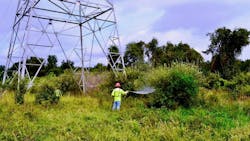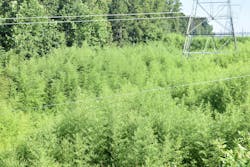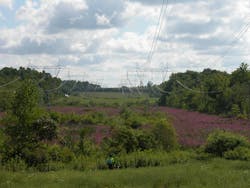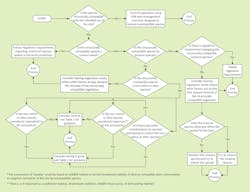Managing Undesirable and Invasive Species on ROWs
The principles of Integrated Vegetation Management (IVM) have gained industry-wide acceptance as best management practices. Three references (ANSI A300 Part 7, ISA BMP - Integrated Vegetation Management, and ROWSC Accreditation Requirements) have codified IVM and aid practitioners in applying the core principles and practices to their organization’s
vegetation management programs.
One of the foundational concepts is differentiation between “compatible” and “incompatible” species, formally referred to as desirable and undesirable species. Structurally compatible species are plant forms that are consistent with and do not conflict with the management objectives for the site. In the case of a transmission line, tall growing trees are incompatible and low- growing plant communities are considered compatible.
As adoption of IVM has expanded, many vegetation managers are beginning to explore what “compatible” means on their systems. Traditionally compatible species and plant communities are favored because they can suppress establishment and development of incompatible plants on a site. This strategy focuses on reducing the likelihood of encroachment of structurally incompatible vegetation to maintain Minimum Vegetation Clearance Distances.
More recently, vegetation managers are broadening their focus to include managing structurally compatible plant communities that can provide a wider range of benefits beyond reliability and safety. This also leads to another question: can a species that is structurally compatible also be problematic in terms of degrading habitat or adversely impacting land adjacent to the ROW? Said another way, can undesirable non-native, noxious or invasive species really be compatible in terms of managing the site? Technically speaking the short answer is yes, but should they be?
Creating the UAA Guidance Document
The Utility Arborist Association (UAA) has developed guidance on how to select vegetation that is structurally compatible and does not represent a threat to the compatible plant communities, ROW habitats or neighboring land use. This is an emerging issue in IVM and utility vegetation management (UVM). The concepts being introduced will evolve with time and experience. It is also important to acknowledge that IVM programs are established by vegetation managers and stakeholders and are specific to each utility’s program.
Adoption of the concepts being introduced in the guidance document are, of course, voluntary. The document is intended to provide some structure to the decision-making process for evaluating maintenance practices applicable to management of non-native, noxious or invasive plants. This is important as a company’s management objectives broaden to consider these plants incompatible for reasons other than conductor clearance.
ANSI A300 (Part 7) defines compatible vegetation as “plant forms consistent with management objectives.” The standard provides potential management objectives for which these considerations may be significant. Some management objectives that may consider species makeup outside of structural compatibility include, but are not limited to, the following:
- Controlling noxious weeds and invasive species
- Improving aesthetics
- Managing pollinator and wildlife habitat
- Reducing the risk of wildfire (e.g. some invasive weeds that are a high-fire threat)
- Restoring ecological and environmental benefits
If a program’s objectives include consideration of more than structural compatibility, the new UAA guidance document can help frame the decision-making process. Understand that, as tolerance levels and action thresholds are established, incompatible plant pressure will need to consider species, density, location and other criteria—not just height.
The Right-of-Way Stewardship Council IVM Accreditation Requirements provides a guidepost to recognize IVM excellence using 10 principles. Principle 8, Accounting for economic and ecological effects of treatment, includes a criterion (8.2) that focuses on environmental viability. That section addresses situations in which a UVM program manager is considering the full environmental costs and requirements of vegetation management activities.
Treatment choices must be made with full consideration of direct and indirect effects, including an array of positive (e.g. ecosystem services) and negative environmental impacts. This means that invasive plants should be managed with adequate planning and appropriate maintenance practices to prevent their spread whenever practical.
Developing a Decision Tree
A decision tree for IVM-based programs can be used to assess species that are structurally compatible with the intended use of the site. At the same time, they have the potential to be problematic due to being a non-native or invasive species or a noxious weed. Four overarching questions are addressed in the decision tree:
1. Is the species structurally compatible with the intended use of the site?
2. Is the structurally compatible species a noxious weed?
3. Is the structurally compatible species an invasive species?
4. Is the structurally compatible species a non-native or alien species?
The UAA guidance document provides complete definitions and cites the authoritative source for classification of species. The following table presents simplified definitions.
The decision tree is intended to help guide a vegetation manager through the decision-making process to determine when it is practical to consider the management of invasive plants and other species that, though structurally compatible, may not be consistent with the management objectives of the site.
Reviewing Practical Considerations
The new guidance document is a first attempt to characterize the decision process involved in applying an expanded definition of the concept of what is compatible and incompatible in the context of IVM. The concept will likely be refined as the industry gains experience.
One of the challenges will be how to strike the right balance between the formal decision process presented in the decision tree and practical application on the ground. For example, what can and should be done if the ROW traverses a site with a large population of “undesirable” (non-native, invasive, and/or noxious) plants? Some examples would include sites with high populations of phragmites, Japanese knot weed, multiflora rose and kudzu. Each of these species does not have the height growth potential to create a direct conflict with overhead T&D conductors, yet each can have an adverse impact on local native plant communities. Active management of invasive and noxious plants on ROW calls for a degree of pragmatism.
One approach worth consideration is to borrow a concept from tree risk management, that being “As Low As Reasonably Practical” (ALARP). Applying this to the concept of compatible species and IVM would help frame an appropriate management intervention. The intensity of a vegetation maintenance action would be at a level that was effective in reducing plant pressure without the expenditure of cost, time and/or effort that is disproportionate to the benefit gained or where the solution is impractical to implement. It is also important to recognize the need for economically efficient allocation of vegetation maintenance resources, focusing on sites with the highest likelihood of suppressing or eliminating an undesirable species.
A committee of subject matter experts created this guidance document to raise awareness of vegetation management industry professionals and to promote shared learning. The practices described may not be appropriate for use in all situations.
The hope is that the new guidance document will stimulate thinking and discussion. It’s also possible that as the concepts are refined, they may be included in an annex to the next edition ANSI A300 Part 7 and an appendix in a future edition of the ISA IVM BMP.
Promoting Environmental Stewardship
The members of UAA’s Environmental Stewardship Committee that created the new guidance document on what is a compatible species. The traditional definition of incompatible is based on whether a plant has to height growth capability to present a risk overhead conductors. The issue being addressed in the document is whether a low-growing invasive or noxious plant can be compatible. The members of the committee who drafted the document include:
- Marie Maiuro, First Energy
- Andrew Mertz, Duke Energy
- Hans Straight, First Energy
- Phil Chen, Overstory
- Stan Vera Art, Grow With Trees
- John Goodfellow, BioCompliance Consulting, Inc





